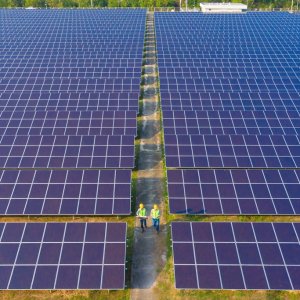
Behind-the-Meter Solar Is Ready to Thrive
 By Cas Biekmann | Journalist and Industry Analyst -
Fri, 07/02/2021 - 13:17
By Cas Biekmann | Journalist and Industry Analyst -
Fri, 07/02/2021 - 13:17
Not that long ago, solar installations were more of a curiosity and an unconventional way to generate energy for those who wanted to help the planet no matter the cost. But photovoltaic solar technology has developed at a supersonic speed ever since. Now, renewable solutions for commercial and industrial (C&I) players are helping to decrease CO2 emissions, becoming a key tool to drive down costs and ensure reliability to boot. The current installed DG capacity of around 1GW will soon be increased sharply, MBN experts believe.
Costs Drive the Race to Net Zero
Decarbonization is a big topic in business around the world, according to industry insiders. With major players pushing for net zero goals, entire supply chains must ramp up their efforts as well. Luckily, renewable energy allows companies to meet sustainability goals and save costs on the energy bill, said Ricardo Whaley, Head of Energy Management & Commercial Office at ENEL Green Power, at Mexico Energy Forum. “Renewable energies are the most cost-effective globally. They offer price optimization coupled with an added value in cleaner energy consumption, which is a growing preference among users.” Whaly, like other experts, highlights the importance of cost as a key motivator to switch to green energy and behind-the-meter solar installations, sometimes complemented with battery storage, which are hard to beat when it comes to cost-effectiveness.
There are other key reasons that could motivate companies to look at such an installation. Quality of energy can be problematic in certain areas of the country that the grid cannot reach. If the sun shines, then solar can provide optimal energy quality because it generates energy right where electricity is consumed. Incentives can be attractive as well:
“Companies that invest in renewable energy generation have a tax incentive that allows them to deduct 30 percent of their investment from taxes in their first year,” said Hans Kohlsdorf, Founding Partner at E2M, at Mexico Automotive Summit.
Behind-the-meter installations fall within the DG threshold, which currently stands at 0.5MW. Hector Olea, President and CEO of Gauss Energía, sees this as a key benefit, among various other advantages: “First, regulation has not changed and the government is sending clear signals that this will remain the case in the future. Second, technological advancements have decreased the costs of photovoltaic and storage equipment, making it very competitive. Furthermore, power tariffs for the C&I segment might very well increase in the medium term, providing another clear incentive to develop solutions for this sector,” he said.
Solar association ASOLMEX and various members of Mexico’s lower house have been seeking to increase the DG limit to 1MW. Whether this initiative will gain further traction is unclear but for smaller installations, 0.5MW might already be more than enough. “Even if a DG installation is 0.5MW by law, there might not be a big enough roof space available to fit it,” explained Olea.
Adaptation Needed for Solar Panel Tech
To successfully design an optimal behind-the-meter system, the best technology is crucial. Utility-scale developments long worked as the basis on which photovoltaic solar technology broke new ground. Solar panel capacity is now growing fast. “The regular power trend for a monocrystalline module two years ago did not change more than 10 or 20 percent a year. Now, we have jumped from a 440W module in December 2020 to a 540W module in 1Q21,” highlighted Juan Ávila, CEO and Co-Founder of Top Energy, in a contribution piece for MBN. Nevertheless, DG installations face very different challenges than large-scale power plants do. As such, leading companies are adapting their product portfolios to meet these needs.
Referring to the larger modules seen in utility scale projects, Iván Reyes, Latam Utility Directorat Tier 1 solar panel manufactuer LONGi Green Energy Technology, saw that adaptations were needed for the product to be successful in DG. “The main problem is that these modules increase in size and weight but not necessarily in efficiency. This is not a problem for utility scale but the DG market often uses rooftops, such as at industrial parks. Such a hefty module might not be suitable for a rooftop installation.” What is more, the high output manufacturers can flaunt turns into a disadvantage against a smaller installation. “A bigger size provides a high amount of current. Inverters designed for DG projects are sometimes not suited for this. It can be a problem for C&I developers to procure inverters that are compatible with such sizes. Efficient, smaller modules that comply with all the technical market conditions are much easier to work with,” Reyes said. Companies focused on inverters such as Huawei and FIMER are rapidly bringing their portfolio up to speed to offer optimal solutions in the C&I sector as well.
Battery storage also helps to further improve the viability of solar, whether in a micro grid or not. Many would associate storage with large, +10MW installations focused on load shifting for a large power plant. Load shifting would indeed be an attractive option but batteries are still expensive, explained said David Fernandes, Country Manager Mexico of ON Energy Storage. But the nature of energy bills in Mexico allows for smaller installations to add a lot of value. “The primary driver for behind-the-meter storage solutions is a reduction of capacity charges, which make up 25 to 30 percent of the energy bill for C&I users. These charges are established in a way that makes so-called peak shaving possible, which is calculated based on peak hours during monthly energy use,” Fernandes said.
Room for Improvement Toward a Promising Future
Overall, DG solar is optimally positioned for explosive growth in Mexico even though a current uptick in solar supply chain prices could slow down development for some time. Even last year, the glimpse of a solar boom could be seen clearly. “DG experienced growth of 30-50 percent over the year despite uncertainty brought on by COVID-19 and the state of the economy,” said Ricardo Cardiel, CEO and General Manager of Latin American Rainmakers.
To make this growth spurt a success and thus solidify the position of DG in the Mexican energy mix, certain aspects could still be improved upon. “We see installation as an issue that stands out in the Mexican market. There are many installers working on DG projects and with some of them, it is difficult to tell if they are well-prepared and qualified to do the work. Therefore, we evaluate and certify photovoltaic DG installers once they fulfill our requirements,” outlined Jesus Serrano, Team Lead at TÜV Rheinland.
To grow renewable energy in the country, developers have long sought to develop projects at the biggest scale possible. However, it is the smallest companies that could benefit from behind-the-meter solar, Cardiel argued. “The big off-takers are not the key but, rather, SMEs. These companies are really suffering from high energy prices. They suffer most from intermittency issues because they are connected to low-voltage outlets but they are unwilling to switch to higher CFE rates,” he said. To maximize Mexico’s renewable potential, SMEs will be crucial.
















